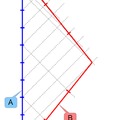The EPR paradox was published by Albert Einstein, Boris Podolsky and Nathan Rosen in 1935. The problem for the EPR paradox is that the state measurements of entangled particles can be spaced far apart, which, in relativity theory, precludes a direct timely causation, yet the results remain consistent and show that the result of one measurement affects the result of the other. The directional dependence of the spin of the entangled particles clearly proves this connection. An earlier interpretation of quantum theory was that spin information is generated when measuring, which, according to the EPR paradox, implies the existence of a hidden parameter that is not contained in quantum theory, and therefore quantum theory is incomplete. However, so far, no hidden parameter has been found, and according to Bell's inequality, there can be no probability variable that can satisfy the quantum theory context. As a result, relativity and quantum theory have so far failed to be compatible.
What I see instead is that when the wave functions collapse, the distance parameter is dropped, so the distance does not affect the measurement. So, we get exactly the same result for the direction of the spins when we measure the state of the entangled particles immediately after they are formed, than when we do the measurements much later and further away. So there is a hidden parameter, and this parameter is nothing more than the wave function itself. This wave function is generated at the time of particles formation and propagates over time or at the speed of light. So you can't really be surprised that postponing your measurements later gives you the same results. The angle function of the spins is determined by the wave function wherever the measurement is made. Thus, it is not one measurement that determines or modifies another measurement, but a wavefunction that has existed since the formation of the particles, but that is only known after collapse at the time of measurement. In addition to the measured quantity, the measurement also provides information on the earlier state of the wave function. Previously, the hidden parameter was understood to be a classic parameter that was proven not to be possible. Conversely, when we understand the wave function as the hidden parameter, the known mystery of quantum theory - that it violates the principle of causality - is shattered, whereas the physical reality of the wave function becomes more explicit. This almost trivial interpretation of the hidden parameter (see Columbus's egg) simultaneously confirms Einstein's causal principle and quantum theory's proven correct predictions, and also answers whether a particle exists before measurement.
Although the interpretation here applies to the EPR paradox, the same may be true in general. Although a wavefunction can be presumed to be spherically symmetric and thus detectable in any direction, it can be deduced after measurement that the wavefunction existed only on the possible path between source and detection, corresponding to the distance of coherence. Thus, the collapse of the wave function may not (in fact) extend to the entire universe, but only to the coherence domain of the wave, while the direction dependence of the radiation emitted from the source remains spherically symmetrical because it is unknown and unpredictable. In the reflection examples, it must be taken into account that reflection is not a single wave function but a simplification of a combination of a large number of wave functions. Further investigations are needed to determine the rules, distances, and accuracy of projection the wave function collapse to the past in various practical cases.
(Translated by Google Translator)


